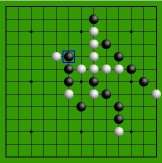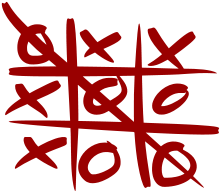Pente
Pente is a strategy board game for two or more players, created in 1977 by Gary Gabrel, a dishwasher at Hideaway Pizza, in Stillwater, Oklahoma.[1] Customers played Pente at Hideaway Pizza on checkerboard tablecloths while waiting for their orders to arrive. Thirty years later, patrons are still playing Pente at Hideaway Pizza, although now with roll-up Pente boards. Pente is based on the Japanese game ninuki-renju, a variant of renju or gomoku that is played on a Go board of 19x19 intersections with white and black stones. Like ninuki-renju, Pente allows captures, but Pente added a new opening rule. In the nineteenth century, gomoku was introduced to Britain where it was known as "Go Bang" (this term is borrowed from Japanese "goban" 碁盤 meaning "go board").[2]
 A sample Pente game | |
| Players | 2–4 |
|---|---|
| Setup time | None |
| Playing time | 5–30 minutes |
| Random chance | None |
| Skill(s) required | Strategy |
History
Pente is a registered trademark of Hasbro for strategy game equipment. Pente (πέντε) is the number five in Greek.
Hasbro ceased distribution of Pente in 1993. It later licensed the name to Winning Moves, a classic games publisher that resurrected the game in 2004. The 2004 version includes 4 extra stones, called power stones, that can be played in the Pente Plus version.
Rules
The players alternate in placing stones of their color on free intersections, with White always assuming the opening move. The players aim to align five stones of the same color in vertical, horizontal or diagonal lines. Captures are obtained by flanking pairs of an opponent's stones in any same direction. Captures must consist of exactly two stones; flanking a single stone or three stones does not result in a capture. For example, if the stones are X O O _ and you place your stone so it becomes X O O X, then your opponent's stones are removed from the board, leaving X _ _ X. A stone may legally be placed on any empty intersection, even if it forms a pair between two enemy stones. For example, if the stones are X O _ X you may place your stone so it becomes X O O X. Your stones are NOT captured in this case. When playing with multiple players the inside stones can be different colors, but the two stones on the outside must be the same colors.
A player wins by scoring five stones in a row. It can be horizontal, vertical, or diagonal. A player can also win by capturing five pairs of opponent stones. Pente can also be played by four people, with pairs of two acting as partners. It can also be played with multiple independent players when each player has their own different colored stones.
Tournament rule
In this common variation, the first player's second move is restricted — it must be at least three intersections away from the center of the board. The tournament rule was created by Tom Braunlich[3] to reduce the advantage held by the first player.
References
- http://www.newson6.com/story/18856286/from-the-kotv-vault-stillwater-inventor-of-pente-hits-it-big-in-1983?clienttype=printable
- OED citations: 1886 GUILLEMARD Cruise ‘Marchesa’ I. 267 Some of the games are purely Japanese, as in go-ban. Note, This game is the one lately introduced into England under the misspelled name of Go Bang. 1888 Pall Mall Gazette 1. Nov. 3/1 These young persons played go-bang and cat's cradle.
- "Playing - Game Rules". Pente.org. Retrieved 19 July 2012.
